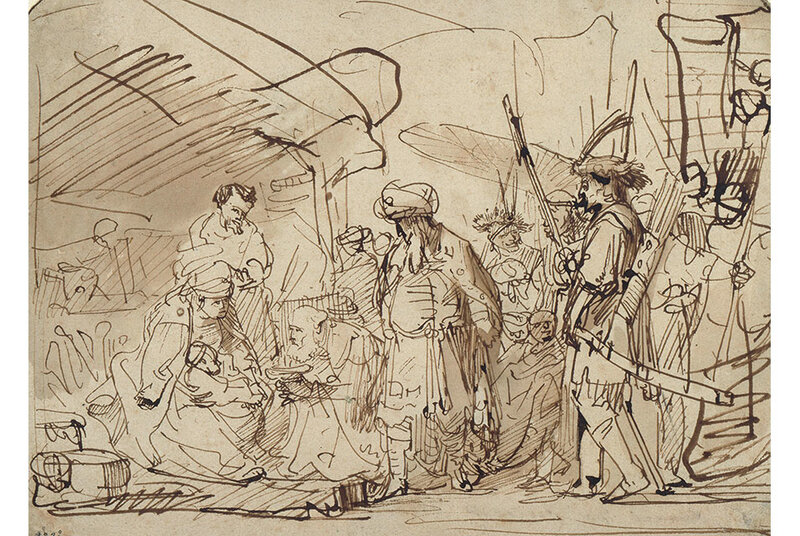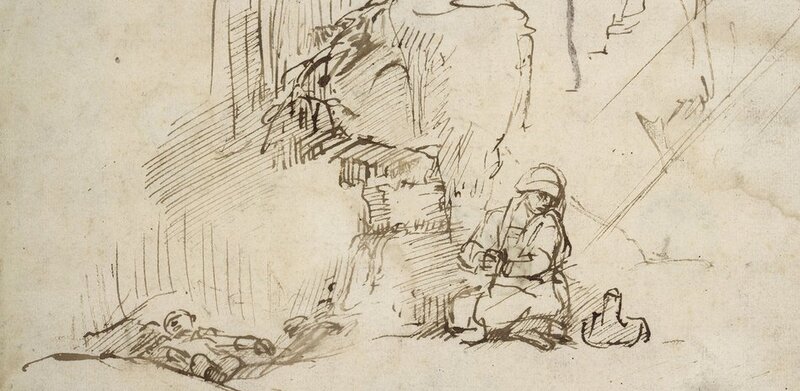Kupferstichkabinett opens exhibition of drawings from the Rembrandt School
Constantijn Daniel van Renesse & Rembrandt Harmensz. van Rijn, The Annunciation to Mary, circa 1652. Pen and brush in brown, black and red chalk, brown and gray wash © Staatliche Museen zu Berlin, Kupferstichkabinett / Jörg P. Anders.
BERLIN.- Rembrandt or not Rembrandt? Drawings by the celebrated Dutch master have always been mixed up with those by his disciples and assistants who worked in the same style. Research carried out over the last years has led to a fundamental reappraisal of Rembrandt’s drawings that also affects the outstanding holdings of the Berlin Kupferstichkabinett. The exhibition presents approximately a hundred of the best drawings by artists in Rem-brandt’s circle as well as several originals by Rembrandt from our own collection and from other museums.
In recent years, the authenticity of Rembrandt’s drawings has greatly ex-ercised the few experts working in this field – with astonishing results: More than half of the drawings listed as autograph in the magisterial cata-logue raisonné compiled between 1954 and 1957 by Otto Benesch, the Viennese art historian and director of the Albertina, are now regarded as works by students and assistants. This has a major impact on the Kupfer-stichkabinett of the Staatliche Museen in Berlin, whose holdings of draw-ings by Rembrandt, his school and his circle are among the world’s largest.
Gerbrand van den Eeckhout, The Adoration of the Magi, ca. 1635–40, pen in brown, brown wash © Staatliche Museen zu Berlin, Kupferstichkabinett/ / Jörg P. Anders
The reason for the uniformity of the drawings and, with it, for the confusion of autograph works by Rembrandt with drawings by other artists lies in the very nature of Rembrandt’s studio practice. Between the 1630s and the 1660s, the artist had numerous students and assistants, some fifty of whom we know by name; many others remain anonymous. Among this throng were young beginners and fully trained artists as well as interested laymen or dilettanti who were attracted by the artist’s reputation. Drawing was central to the training in Rembrandt’s studio. Students were expected to master biblical and historical scenes. They learned how to capture, compose and stage dramatic narratives in the medium of drawing, how to use light and shadow, the poses and expressions of the human figure. Rembrandt showed them his own drawings which often served as direct models and teaching aids. Joint life drawing sessions in the studio and excursions to do landscape studies out of doors also formed part of the training, and the master and his students would often work on the same subjects, either in groups or parallel.
For Rembrandt’s students it was near-impossible to escape his formative influence – at least during the time they spent in his studio. It was not until later that some were able to shake off his powerful presence and develop a style of their own. Some even forged new paths in terms of technique. Others, however, remained forever beholden to Rembrandt’s manner.
Willem Drost, Hagar and Ishmael in the Desert, ca. 1650, pen in brown (Detail) © Staatliche Museen zu Berlin, Kupferstichkabinett/ Jörg P. Anders
It must be assumed that those drawings by Rembrandt and his students that were produced as part of the students’ training in the master’s studio were kept together in albums. Thanks to old inventories of Rembrandt’s property from 1656 and 1669, we know that the drawings were organised by subject – for example landscapes, animals, biblical scenes. Hardly anything was signed. A very small number of Rembrandt’s drawings are inscribed in his hand; drawings by students in training do not feature au-thentic signatures. In total, there were probably some 1500 to 2000 sheets. They came onto the market in several batches in 1658 and after the artist’s death in 1669. And from an early date, dealers and collectors alike were unable to tell works by Rembrandt and those of his students apart.
The Kupferstichkabinett is following up on its critical catalogue of Rem-brandt’s autograph drawings (published in 2006) with an inventory of its holdings of some 160 drawings that had previously been attributed to Rembrandt himself, but which have since been identified as works by art-ists in the master’s circle. The catalogue will be complemented by an ex-hibition of approximately 100 drawings by Ferdinand Bol, Willem Drost, Gerbrand van den Eeckhout, Arent de Gelder and other artists from Rem-brandt’s circle.
Constantijn Daniel van Renesse, Landscape with Two Houses under Trees, ca. 1653, pen in brown, brown wash (Detail) © Staatliche Museen zu Berlin, Kupferstichkabinett
A small selection of Rembrandt originals from the rich holdings of the Kup-ferstichkabinett and other collections invites visitors to take a closer look at the similarities and subtle differences between the works by Rembrandt and his school and provides a fascinating insight into the way drawing was taught in the master’s studio.
The exhibition is accompanied by a catalogue raisonné published by Sandstein Verlag, Dresden.

/https%3A%2F%2Fprofilepics.canalblog.com%2Fprofilepics%2F1%2F0%2F100183.jpg)
/https%3A%2F%2Fstorage.canalblog.com%2F03%2F02%2F119589%2F96711876_o.jpg)
/https%3A%2F%2Fstorage.canalblog.com%2F11%2F31%2F119589%2F94773502_o.jpg)
/https%3A%2F%2Fstorage.canalblog.com%2F20%2F83%2F119589%2F94772815_o.jpg)
/https%3A%2F%2Fstorage.canalblog.com%2F26%2F72%2F119589%2F75604929_o.jpg)
/https%3A%2F%2Fstorage.canalblog.com%2F59%2F60%2F119589%2F26458628_o.jpg)






/http%3A%2F%2Fstorage.canalblog.com%2F50%2F26%2F119589%2F117901230_o.png)
/http%3A%2F%2Fstorage.canalblog.com%2F91%2F45%2F119589%2F129453113_o.jpg)
/http%3A%2F%2Fstorage.canalblog.com%2F10%2F81%2F119589%2F127170196_o.jpg)
/http%3A%2F%2Fstorage.canalblog.com%2F39%2F71%2F119589%2F117845332_o.jpg)